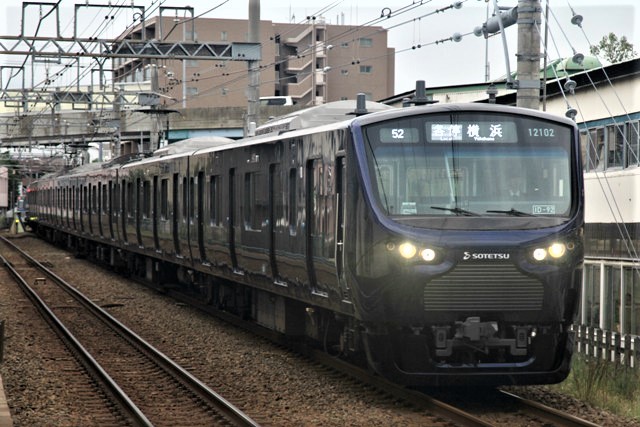EMU Sotetsu 12000 series arrives at Wadamachi station
Following the EMU 20000 series, Sagami Railway (Sotetsu) launched another new train named the EMU 12000 series in April 2019. The 12000 series is planned to directly operate onto the JR East line from November 30th this year; meanwhile, the 20000 series will be directly operated onto the Tokyu line from 2022.
There are 8 major private railway companies including Sotetsu in the metropolitan area, but Sotetsu is the only company, which doesn't run into downtown Tokyo. Sotetsu's fatal weakness for business is their railway network. Under the environment of future depopulation in the metropolitan area, what is Sotetsu's strategy? They plan to operate direct access trains to downtown Tokyo and enhance convenience for passengers. How? Sotetsu is constructing connecting lines from Nishiya station to the existing JR East line and the Tokyu lines respectively.
The 12000 series and the 20000 series are similar in appearance, but there are big differences in the specifications between the two. For instance, the 12000 series doesn't have a gangway; while the 20000 has a gangway on the front. The 12000 series has stainless-steel bodies; while the 20000 series has aluminum ones. The electric control system of the 12000 series is IGBT-VVVF inverter (variable frequency drive with Insulated-Gate Bipolar Transistor); while the 20000 series has an advanced VVVF inverter system with hybrid SiC modules. These differences are due to the conditions of direct operation lines.
Sotetsu plans to introduce a total of 6 sets, 60 units of the 12000 series by the end of March 2020.
There are 8 major private railway companies including Sotetsu in the metropolitan area, but Sotetsu is the only company, which doesn't run into downtown Tokyo. Sotetsu's fatal weakness for business is their railway network. Under the environment of future depopulation in the metropolitan area, what is Sotetsu's strategy? They plan to operate direct access trains to downtown Tokyo and enhance convenience for passengers. How? Sotetsu is constructing connecting lines from Nishiya station to the existing JR East line and the Tokyu lines respectively.
The 12000 series and the 20000 series are similar in appearance, but there are big differences in the specifications between the two. For instance, the 12000 series doesn't have a gangway; while the 20000 has a gangway on the front. The 12000 series has stainless-steel bodies; while the 20000 series has aluminum ones. The electric control system of the 12000 series is IGBT-VVVF inverter (variable frequency drive with Insulated-Gate Bipolar Transistor); while the 20000 series has an advanced VVVF inverter system with hybrid SiC modules. These differences are due to the conditions of direct operation lines.
Sotetsu plans to introduce a total of 6 sets, 60 units of the 12000 series by the end of March 2020.
EMU Sotetsu 12000 series leaves Wadamachi station
Official promotion movie, the test run of direct operation
between Sotetsu and JR East lines using the EMU Sotetsu 12000 series:
Official information, the trains on the Sotetsu line (in Japanese):















